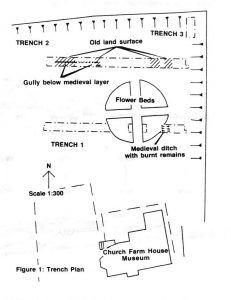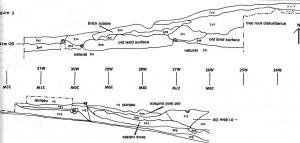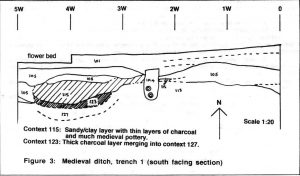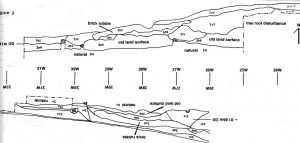NO.279 JUNE 1994 Edited by Mick, Watkins
DIARY
Saturday 18 June OUTING TO ABINGDON & DORCHESTER-ON-THAMES
– with Micky Cohen and Micky Watkins.
Details and application form enclosed.
Saturday 9 July OUTING TO RICHBOROROUGH AND BISHOP’S PALACE MAIDSTONE
-With Tessa Smith and Sheila Woodward
Tuesday-Saturday ISLE OF MAN
9 – 13 August Our group is full up and we have 3 members on the waiting list, but further
names can be added if you wish: ring 203 0950. Dorothy writes
enthusiastically about this expedition – see page 6.
Saturday 3 September OUTING TO NEW BUTSER SITE, OLD WINCHESTER HILL & ALTON -with Bill Bass and Vikki O’Connor
Saturday 16 July CRICKLEWOOD COMMUNITY FORUM, 10.00am-4.00pm
at St. Peter’s Church Hail, Cricklewood Lane, Local societies and groups will be represented. Volunteers needed to man a possible HADAS stand.
16 April – 26 June BURGH HOUSE, NEW END SQUARE, HAMPSTEAD
“SO NEAR TO HEAVEN”. An exhibition celebrating Hampstead Heath’s history and scenery.
A display of HADAS flint finds is included.
Tuesday 4 October EXCAVATING IN EGYPT
Lecture by Dr Patricia Spencer
Saturday 8 October MINIMART
Saturday 29 October CITY WALK with Mary O’Connell
ANNUAL GENERAL MEETING. 3 MAY 1994.
CHAIRMAN’S REPORT
HADAS has had a very successful year carrying out two major excavations. Our first excavation took place in the summer in the elegant surrounding of the garden of the Church Farm Museum. Here evidence for Medieval or indeed post Medieval Hendon was slight though we did uncover part of a Medieval rubbish deposit. Further excavations are needed preferably in the front garden of the Museum if we are to discover the medieval building that surely exists there. Brian Wrigley, who directed the excavation, also lectured about it to the London and Middlesex Archaeological Society.
In the winter we then carried out a rescue excavation in the less salubrious area of the former Victoria Maternity Hospital in Wood Street, Barnet. This was in the depths of the winter – December and January! It was our first excavation carried out under PPG 16 (Planning Policy Guidenote No 16) in order to provide clearance of the site for the developers. This we were able to do, in that we failed to find any medieval structures, though we did find a medieval ditch running under the listed Georgian building. A 19-page report on this was prepared by Bill Bass, Roy Walker and Brian Wrigley for the developers and English Heritage within a month of completing the excavation. This is the first PPG 16 excavation carried out by a local society anywhere in London.
Work on post-excavation continued most weekends at Avenue House. The report on the site of the Old Forge in Golders Green Road, excavated in 1991, is now nearly complete and work on Church Farm House is well advanced.
OTHER ACTIVITIES
A technical seminar was held on the 16th May on Church Farm House in preparation for the excavation as a result of which a set of guide notes was prepared.
A full programme of lectures and visits took place throughout the year. The highlight was the weekend visit in September to Chester and Llandudno where the Society visited the Bronze Age Copper Mines.
A highly successful Christmas Dinner was held at University College where the Society viewed Jeremy Bentham. The Minimart was held on 16th October and raised £1,300. The monthly newsletter was published regularly throughout the year.
OFFICERS
The Society is delighted to welcome Will Parnaby as its new Hon. Treasurer.
The time has come to say farewell to our President, Ralph Merrifield, who is retiring after four years in office. Ralph was only our second President, the first President, Professor Grimes having served from our foundation until his death. Ralph Merrifield has been an exemplary model of our new policy of keeping our Presidents for a fixed term of office and we are delighted to have seen so much of him. Following his retirement he will become an honorary member and we hope he will continue to visit us. We welcome as his successor Michael Robbins, the former President of the Society of Antiquaries. He is our leading railway historian and was formerly managing director of the London Underground.
In conclusion can I express my thanks especially to Dorothy Newbury for running the lectures, visits and Minimart so successfully; to Vikki O’Connor for her valiant work as Membership Secretary; and to all my fellow officers, the committee and the members of the Society for all their help and support throughout the year.
RALPH MERRIFIELD told us that he had many regrets in resigning from the office of President, but nowadays, he said, when he gets into a hole to view an excavation he has difficulty in getting out of it! He praised the work of HADAS, the most active of all London societies, and wished us the greatest success for the future.
Andrew Selkirk said that in the eyes of most people Ralph is “Mr Roman London”, and his vote of thanks to Ralph was heartily endorsed by Society members.
MICHAEL ROBBINS was unanimously elected as our new President. ELECTION OF OFFICERS
Our Vice-Presidents were confirmed in office:John Enderby, Miss D.P.Hill, Brian Jarman, Daphne Lorimer, Mary Phillips and Edward Sammes.
Officers were re-elected: Andrew Selkirk as Chairman, Brian Wrigley as Vice-Chairman, Liz Holliday as Hon. Secretary, Will Parnaby as Hon. Treasurer.
A Committee was also elected: Bill Bass, Micky Cohen, Victor Jones, Dorothy Newbury, Vikki O’Connor (previously co-opted), Peter Pickering, Edward Sammes, Andy Simpson, Myfanwy Stewart, Roy Walker, Micky Watkins.
“BARNET BEFORE DOOMSDAY” : FILM SHOW AFTER THE AGM
This film is a surprise and delight for HAAS members. It is a really professional film on the archaeology of our area, made for Channel 4, though never broadcast. The stars are all well known to us: Brigid Grafton Green, Isobel McPherson, Helen Gordon, Paddy Musgrave, Daphne Lorimer, Ted Sammes. Sadly we have lost Brigid, Isobel, and Paddy, but the film brings them to us again and will be treasured by their families and friends. The general geological and archaeological development of the North Thames area is presented by Steve Harman of Channel 4, who uses maps and diagrams to show us how this hilly area on the edge of the Thames basin has some special qualities which made it a desirable residential area for our mesolithic ancestors as well as for the Romans and ourselves. Daphne Lorimer at the West Heath site showed us flints used for arrows and for scrapers, and demonstrated knapping for us. Ted Sammes was at Church End, Hendon, and explained that the high hill and good views made it a desirable settlement for both Romans and Saxons. Brigid Grafton Green showed us a mortarium from Brockley Hill demonstrated how it was used to grind herbs and spices, and actually made up a recipe for a Roman marinade. Isobel Macpherson and Helen Gordon showed the probable courses of Roman roads on maps, and then walked some of them with the camera team. Paddy Musgrave showed how hedges could be dated by the number of species and told us that a hedge in Lyttleton playing field was probably 700 years old. All our ‘stars’ gave really interesting and clear explanations of the finds, there was no nervousness, but a great enthusiasm to communicate.
Our thanks to Tessa who made copies of the film, and to Christopher Newbury who wired up the video and provided us with 2 screens. Another showing may be possible if enough members are interested.
There was a fine display, mounted by Bill Bass, of the work at Church End, Hendon and at the Victoria Maternity Hospital in Barnet, and we had the pleasure of handling the pottery finds.
“RUSTIC WALKING ROUTES IN THE LONDON VICINITY”
Our thanks to Dr Finch for sending us photocopies from this guide book of c. 1900. The cover shows two ladies sensibly dressed with ankle-length skirts and large hats. Despite all this clothing, the ladies could step out, for the walks are 6 to 8 miles long. It would be fun to try one of the walks, guide in hand, for instance, between Hendon and Edgware, down Church Lane take “the gate of a path which passes under two railway arches, and then runs through meadow after meadow for about two miles (skirting the Silk Stream at times), until at length it merges into a traffic road”. (see this guide in Avenue House Library)
MICHAEL ROBBINS C.B.E., our new President, has worked for many years in London Transport. After war service in the Royal Engineers, he re-joined the London Passenger Transport Board and became a member of the London Transport Executive and Managing Director of Railways. But in addition to this important career in transport, he has many publications including “The North London Railway”, “Middlesex Parish Churches”, “The Railway Age” and “History of London Transport”. Amongst his many other offices, he has been President of LAMAS, and of the Society of Antiquaries, and Chairman of the Museum of London. We are delighted that he has accepted the office of President of HADAS.
EXCAVATION NEWS from BRIAN WRIGLEY
Church Farmhouse Site. We are carrying on with the processing of finds, and with the paper-work necessary for the interpretation of the site.
East Heath Boundary Ditch. We would be glad of help from anybody who knows about the topography, geology or vegetation of the area. Or indeed anybody who has done any documentary research on the old boundaries might help us in our survey.
MEMBERSHIP NEWS from VIKKI O’CONNOR
We are pleased to welcome Mr and Mrs H.Burgess to HADAS. They may already be known to some of our members as fellow members of the Finchley Society.
After seven years as a HADAS member, Micaela Graham-Yooll and her husband have moved to Argentina. She sends her best wishes to the Society, adding that they can still be contacted through their London address during the summer.
Most members have now renewed their membership, but as 1st April is now two months past – a quick reminder.
Thank you, John Heathfield, for last month’s note on the East Finchley hog market: there is obviously quite a long story behind this. ( I believe the date of 1860 for “The George” was a misprint and should have read 1660? ).
TED SAMMES SEES THE QUEEN
at the 150 Year Celebration of the Royal Archaeological institute.
“On May 11th the Institute held a reception at St James’ Palace in the presence of Her Majesty the Queen. This event was to a degree informal and I must confess that I enjoyed it very much. It was timed to start at 5.45pm and end at 8pm. Not merely was it a chance to mingle with the other 450 members who were present, but to see the Queen at close quarters with no obvious barriers.
Three reception rooms were used to accommodate us all, the Throne Room, the Entree Room and Queen Anne Room, all on the first floor of the Palace. The Royal pictures, the thickness of the carpets and the general brightness of the decoration all excited interest.
Towards the end of the reception, Andrew Saunders M.A.,F.S.A., the current President of the Society and one of our Vice Presidents, presented the Queen with a bound copy of the latest issue of the Archaeological Journal.
The Queen stayed for two hours. After her departure we were free to wander through other state rooms and the Chapel.
It was an occasion to meet many friends and acquaintances, amongst whom I espied Ralph Merrifield and his wife and five other HADAS members.”
WHAT THE PAPERS SAY
DINOSAUR BONES – WHO OWNS THEM?
Two amateur collectors have unearthed bones of a Polacanthus on a beach at Brighstone, Isle of
Wight. One collector gave his finds to the Island’s geology museum, but the other intends to display his share of the finds in his own rival museum. We hope the Polacanthus remains can be re-united!
(Daily Mail April 1994)
SEABED ARCHAEOLOGY
Wrecks, war defences, iron-stone workings and a submerged forest are some of the features that have been discovered below the sea on the coast of Durham and Yorkshire. The North East of England is taking the lead in carrying out an archaeological survey in territorial waters, up to 12
miles out to sea. This is part of a survey of all our territorial waters initiated by the Royal Commission on Historical Monuments in 1992. One very precious find is a piece of woven wood which is thought to be part of a 7000 year old fish-trap. It was discovered by a local pensioner.
(Weekend Telegraph 7 May)
HEVENINGHAM HALL
Those who went on the HADAS visit with John Enderby some years ago may know that after 1981 the house was ‘modernized’ by an Iraqi businessman – 20 bathrooms, holes punched in plasterwork for light fittings! It is good news that the house has changed hands and is now going to be restored.
FAMILY PLANNING IN GREECE AND ROME
From written sources, such as Aristophanes and Pliny, historians know that women used herbal medicines to stop conception, but until recently the effects were supposed to be more magical and illusory than real. Now scientists are finding that medicines prepared from pennyroyal, pomegranates and date palm do in fact reduce fertility. A teaspoonful of Queen Anne’s Lace seeds in water can work as a `morning-after’ pill. The researchers conclude that “women in antiquity had significant control over their reproductive lives”. HADAS members are advised to try less ancient methods.
(Archaeology 47 as reported in The Times 5 May)
A JAPANESE INVENTION for reducing adverse wind currents caused by high-rise buildings is based on the flying buttress principle of medieval cathedrals.
( Daily Mail 8 April )
500,000 YEARS AGO THEY WERE TALLER THAN US
The oldest human remains ever found in Britain have been dug up in a quarry at Boxgrove, near Chichester. They date from time when homo sapiens were evolving. The bone is a tibia – lower leg bone -and as it is larger than in the average modern man, it is suggested that Sussex Man may have been 6ft 3ins tall!
The discovery was made by Dr Mark Roberts of the Institute of Archaeology, London. Boxgrove is one of the most important paleolithic sites in the world. These early inhabitants were living on the foreshore as the sea was higher then, and lived by gathering shellfish,roots and berries, scavenging and hunting. (Independent 18 May)
21 YEARS BACK – NOSTALGIA from DOROTHY NEWBURY Newsletter No 28. June 1973
The 12th Annual General Meeting
“Mr Jarman also reported the Society’s highest ever membership – 174. He emphasised that our most urgent need, if the Society is to go on from strength to strength, is permanent accommodation where we can store our tools, finds from excavations, archives, etc., and work on our various projects. Mr Edward Sammes, who read the Research Committee’s Report, also emphasised this need.”
21 years on and the problem is the same, only we have 20 times the amount of stuff to store.
Dating – An Unexpected Problem – More Nostalgia
“From time to time the Society receives some curious enquiries. On the whole they are, as you might expect, for an archaeological society, of the earth, earthy. Recently, however, a problem with an almost ethereal quality cropped up.
It came in a letter from an author in Reigate, who is preparing a book on the ghosts of London. “I am told,” he wrote to our Hon.Sec., that there have been reports of a ghost of a nun seen in the Lawrence Street vicinity, near the entrance to St. Joseph’s College. Some accounts refer to a sound of singing. I wonder if you can throw any light on this? A date, perhaps? Our Hon. Sec., – who feels a trifle more at home dating a Roman pot than a spirit – was nonplussed; but Mr Wookey, presiding at the A.G.M., gallantly leapt into the breach. He asked all present at the meeting to produce some more facts about this ghost.
One member promptly came up with what maybe the answer – that this is no nun, but instead the ghost of poor Nan Clark, who left her name behind her in Nan Clark’s Lane, Mill Hill. She was a serving maid who was foully murdered in the Lane; and she is said to walk there of a Midsummer Night.
Should any Newsletter reader be able to pad these facts out further (particularly with the desired date of Nan Clark’s demise); or should anyone be able to offer another contender for this ghostly title, the author in Reigate will doubtless be highly delighted.”
ISLE OF MAN from DOROTHY
The more I delve into the history of the Isle of Man the more interesting it becomes. – Round houses, hill forts, Viking ship burials, megalith tombs, early Christian and Norse carved memorial crosses (200 of them), some in situ and some in the Manx Museum; Civil War forts, Medieval castles, unspoiled village folk museums, and the largest working waterwheel in the world, bringing us up to the 19th century.
Most of this came to light in the last war when a famous German archaeologist, Gerhard Bersu, was interned there, having left Germany when Hitler came to power. You couldn’t keep a good archaeologist down and he persuaded the authorities to provide him with 40 diggers from the internment camp. He proceeded to excavate continually, winter and summer, for the rest of the war. (see Current Archaeology No 27 July 1971)
CHURCH FARMHOUSE MUSEUM from GERRARD ROOTS
The restoration of the Museum roof continues apace: the old roof has been stripped, the decayed straw removed and the rethatching is now underway. Everything seems on course for our re-opening on 25 July.
Among the many activities going on during closure is the setting up of a schools’ loan collection of Victorian domestic artefacts. The Museum needs to acquire duplicates of its more interesting cooking, cleaning and washing objects for these loan boxes, and I would be very pleased to hear from any HADAS member who might have suitable material. Examples of the kind of things I am looking for are on display at Hendon Library until 25 May.
Gerrard would be very grateful for any help. Please ring 081 203 0130.
HENDON CHURCH FARM HOUSE EXCAVATION 1993
INTERIM REPORT, JUNE 1994
SUMMARY
This site lies on the slope, down to the north west, from Hendon Parish Church which stands on a plateau of higher ground between the valleys of the Dollis Brook/River Brent and the Silk Stream, the higher ground being capped by glacial sands over the London clay. Previous archaeology has shown Saxon and medieval occupation on the plateau near the church, with some pottery evidence of Roman activity. It seems likely that this was the centre of occupation of Hendon as referred to in Domesday.
The site itself is historically documented as having been the back yard of a farm from at least the 17th century, the farmhouse of that date still surviving as Church Farm House museum, a listed building. Documentary evidence indicates that in the 18th century there were buildings over most of the site behind the farmhouse, but these had disappeared before the 19th century OS maps.
It was therefore expected that we should find considerable man-made disturbance to the ground, but in addition to this it was found on excavation that there had been considerable natural soil movement downhill of sandy subsoil from the glacial capping, overlying a previously exposed land surface. This complicates the interpretation of dating from the artefacts found, and makes it important to use care in interpreting artefacts contained in any contexts as being in the same place that they were originally deposited.

With this caution in mind, nonetheless, there are three features found which can confidently be regarded as in their original place:
1. A narrow shallow gully cut into the old land surface, traced over a length of approximately 12 metres;
2. A small pit cut into the old land surface which included four medieval sherds:
3. Section of ditch running north/south filled with burnt material and a large amount of medieval pottery. The trench plan (figure1) shows the extent of the excavations with the positions indicated of the main features found.
The intention was to open up and explore as wide an area as reasonable, taking in the more interesting looking contours of the present surface, so as to give a general view and suggest likely matters for further detailed examination. This strategy seems to have worked (or as some might say, we have raised more questions than we have answered!)
Trench 2, in the northern part of the site, is where the landslip was most evident, which is consistent with the general downward slope of the land towards the north west. Figure 2 is a section diagram, (much reduced) of the layers found, showing the quite deep layers interpreted as being the landslip. These layers include numerous artefacts from medieval (c1150) to modern, and are topped by a humic soil above which is a line of bricks appearing to be the remains of an edging to the garden path shown in a mid-19th century OS map, suggesting that the landslip occurred between those dates. The gully and the medieval pit found were cut into the sandy clay layer, the old land surface, below these landslip layers.
Trench 1 showed considerable disturbance of soil rather from human activity than from landslip. The most notable feature was what appears to be a section of medieval ditch running north/south, shown diagrammatically in section in figure 3. The soil below this feature, into which it was partly cut, is of similar description to the old land surface found in trench 2, and it is in this layer that a few Saxo-Norman and Saxon sherds were found.
Trench 3 was started late in the dig and did not get beyond modern disturbance.

MATTERS REQUIRING FURTHER INVESTIGATION
1. Establishing the extent of the surviving old land surface and its slope and conformation.
2. Seeking any more features in the old land surface and their period.
3. Investigating the extent of the surviving medieval ditch and its possible relationship with the Saxon and medieval ditches found in the Church Terrace excavation of 1973/4.

POSSIBLE FURTHER INVESTIGATIONS
Now that our initial wide exploration has given us a better idea of where interesting features may lie below, some further investigations can be suggested of a more limited and less destructive nature.
1. A contour plan of the present surface would be of great help in interpreting the past earth movement found. Figure 4 is a diagram of two contours (83 and 84m OD) which can be approximately placed from measurements of levels already taken, and we should extend this to cover the whole site with measured levels.
2. Resistivity testing in detail in selected areas could pick up:
(a) The continuation and extent of the medieval ditch feature, and
(b) Features in the buried old land surface.
However, we know from experience that on this kind of soil, resistivity results are unlikely to be clear-cut enough to be relied on without the back-up of being tested by probing.
3. Probing by auger could help to confirm (or deny) resistivity results and could also pick up the old buried land surface enabling us to see the extent to which this survives and perhaps to make a contour plan of it.
4. Excavation. Following these investigations we can consider whether the results point to further limited and detailed excavation in selected places.


